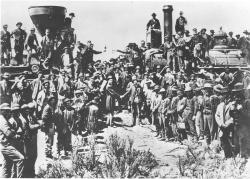
"May God continue the unity of our Country as this Railroad unites the two great Oceans of the world."
- Inscription on the ceremonial Golden Spike
The symbolic Golden Spike, staked in Promontory, Utah in 1869, marked the completion of the first transcontinental railroad, joining the Union Pacific Railroad from the East and the Central Pacific Railroad from the west.
The spanning of the continent, over mountains and across deserts, proved a turning point in American history. It tied the country together, paving the way for nationwide development and commerce. It was one of the greatest civil engineering achievements of the time. Newspapers heralded its completion as one of the most significant events in the nation's history.
At noon on May 10, 1869, a crowd of 1,500 assembled in Promontory for the ceremony to join the rails. As trains from the east and the west idled a scant two rail-lengths apart, dignitaries drove the final, golden spike into a tie of polished California laurel. The trains then inched toward each other, touching noses amidst a background of champagne celebrations.
For more information, view the History Lesson article, Uniting the States: The First Transcontinental Railroad .


